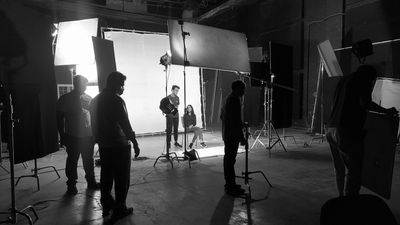Equipment Knowledge and Skills

The world of equipment is vast, and every cinematographer has their trusted toolkit. My experiences have allowed me to familiarize myself with a wide range of cameras, from classic film to cutting-edge digital, various lenses, rigs, and intricate lighting setups. This section will take you through my preferred equipment and why they resonate with my style of work.
Equipment Knowledge
The foundation of my cinematography journey lies in a tool more intricate and reliable than any piece of technology: my eyes. With over 13 years of hands-on experience, I've learned to rely on them to interpret and express the world in a unique way. They serve as my guiding compass, enabling me to translate my vision into art using the equipment I trust.
Over the years, I've fostered a deep relationship with cameras, each having its strengths and unique characteristics. Predominantly, I've operated with Sony, which has been the backbone of many of my projects. I've also dabbled in the powerhouses from Red, notably the Monster and Helium models, capturing visuals in staggering 8K. Canon and other mirrorless cameras like the A7S3, A7S2, and A73, has also been an essential part of my toolkit.
Venturing beyond cameras, I've skilfully wielded an array of equipment essential for the modern cinematographer:-
Stabilization: Mastery in using gimbals and Panthers for fluid movement and steady shots.
Lighting: Proficient with an extensive array of lights, including Arri lights, HMI, the powerful 4K and 12K, Solar, Baby, Dinos and the other versatile Sky Panels.
Other Skills
- Storyboarding & Pre-visualization: Before capturing a scene, visualization plays a critical role. Creating storyboards and using pre-visualization tools allows for planning shots, understanding transitions, and ensuring the narrative flow.
- Color Theory & Grading: A scene's mood and tone are often defined by its colors. Having a solid grasp of color theory and the ability to execute effective color grading in post-production is paramount.
- Camera Movement & Blocking: Understanding how to move the camera in relation to actors and the environment is key. It's not just about where the camera is, but how and when it moves.
- Lens Choice & Depth of Field Management: Different lenses offer varied perspectives. Knowing when to use a wide-angle versus a telephoto lens or how to manipulate depth of field can drastically change a shot's feel.
- Lighting Design: Beyond the basics, advanced knowledge of how to shape, color, and control light can create atmosphere, depth, and drama in a scene.
- Sound Design & Integration: While primarily a visual medium, understanding how sound design complements cinematography can elevate the overall impact of a film.
- Post-production Collaboration: Working closely with editors, sound designers, and other post-production professionals ensures the visual story remains consistent and true to the initial vision.
- Adaptation to Different Genres: Each film genre, be it horror, romance, or sci-fi, has its unique challenges and stylistic nuances. Adapting and mastering the requirements of various genres is a testament to a cinematographer's versatility.
- Tech Adaptability: The film industry is ever-evolving, with new tools and technologies emerging regularly. Staying updated and integrating new tools can enhance the storytelling process.
- Collaborative Mindset: Filmmaking is a collaborative effort. The ability to communicate vision, accept feedback, and work harmoniously with directors, actors, and crew is crucial.
